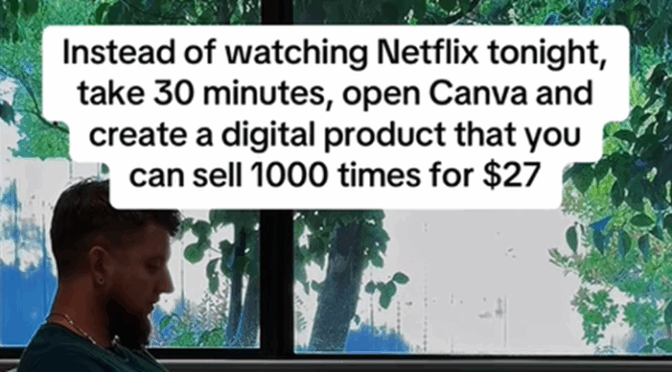SELLING DIGITAL PRODUCTS ONLINE: Are the claims true?
The $27 Canva Product Myth: Can You Really Make $27,000/Month Selling Digital Products Online?
If you’ve spent more than five minutes on social media lately, you’ve probably seen this viral advice:
“Instead of watching Netflix tonight, open Canva, take 30 minutes, create a digital product you can sell 1,000 times for £27, and boom — £27,000/month.”
It sounds tempting — even logical. Just create a simple eBook, planner, or template, pop it on Gumroad or Etsy, and let the cash roll in.
But before you cancel your Netflix subscription and fire up Canva, let’s take a closer look at what’s really going on here — and what the influencers pushing this idea often leave out.
Let’s break this down and explore how this works in practice, how realistic it really is, and why you should be cautious before jumping in.
How This Works (In Theory)
The basic concept is this:
-
Create a digital product (like a planner, checklist, or workbook) using Canva
-
Upload it to a platform like Etsy, Gumroad, or Shopify
-
Set your price (often £27 is the magic number)
-
Sell 1,000 copies per month
-
Repeat and scale
-
Retire early on “passive income”
Sounds easy, right?
It’s pitched as low-effort, high-reward, and easy for anyone to do — no experience needed.
But reality? Much more complicated.
How Easy Is It to Set Up a Digital Product?
Creating a digital product and setting up a shop can be fairly simple, technically speaking:
✅ Canva is user-friendly and free
✅ Gumroad, Etsy, and Payhip are easy to list on
✅ You don’t need to handle inventory or shipping
There are templates to help you create a product quickly
But here’s the tricky part:
❌ Creating a product people actually want takes skill and research
❌ Your design, copywriting, and branding need to look professional to compete
❌ Standing out in a sea of thousands of similar products
❌ There’s no guarantee anyone will find or buy your product
❌ Setting up payment gateways, refund policies, email lists, etc.
Reality check: It’s not impossible, but it’s not “30 minutes and done.” The upfront time investment is usually 10–30 hours for product creation, branding, and store setup if you’re doing it seriously.
How Easy or Hard Is It to Promote Your Product?
This is where it really gets tough. Promotion is where the fantasy usually crashes into the wall of reality. How do you actually get people to buy your product?
Organic Promotion (Free but slow)
• Posting on Instagram, Pinterest, TikTok
• Building an email list
• Relying on SEO or Etsy search
You’ll need consistent content, a marketing strategy, and patience. Most people see little to no sales at first, although it’s easier if you already have a big audience on Instagram, TikTok, or YouTube.
Time cost: High
Financial cost: Low
Result: Maybe a few sales if you’re consistent and learn fast
Paid Ads (Fast but expensive)
• Facebook/Instagram ads: £5–£100/day
• Average cost to acquire one £27 sale: £10–£25+
• A lot of testing and failure before success
If you don’t already have experience with digital marketing, running profitable ads is not beginner-friendly. And it’s easy to burn through cash without results. Plus, you’re in a saturated niche, and competition is high.
Time cost: Medium
Financial cost: High
Result: Could work — but you’ll probably lose money learning
Who’s Really Making Money?
Let’s get brutally honest:
The people making the most money from this idea aren’t selling £27 planners — they’re selling you the dream of selling £27 planners.
They make money by:
• Selling courses on how to create digital products
• Offering paid memberships with templates or coaching
• Getting affiliate commissions for promoting tools like Canva, Gumroad, and ConvertKit
In other words: you’re their real source of income, not people who want to buy digital products, planners, eBooks, etc. but people like you who want to learn how to make and sell these products.
This doesn’t mean all of them are scammers. But it does mean their success isn’t always coming from where they say it is.
They dangle a shiny example like “£27 x 1,000 sales = £27K/month” — but skip over:
• The months (or years) of failed products before that
• The money lost on ads
• The luck factor involved
• The size of their audience
And worst of all — you start to feel like a failure if you can’t replicate their results.
If It Worked So Well… Why Would They Want More Competition?
This is the question you really need to ask yourself:
Let’s be honest: If you woke up one day and found a magic formula for passive £27K/month income would you:
A/ Keep it a secret and make as much money as you could while it worked?
B/ Tell the whole world about it and increase your own competition?
Teaching others how to do it only makes sense if:
• Their own products are not selling
• They’ve realised courses and information products are more profitable
• They need to constantly bring in new hopefuls to make money
In short: you becoming their competitor isn’t a concern — because you’re not. You’re helping fund their next big month.
So… Can Selling Digital Products Still Work?
Yes — but not in the way it’s sold to you.
If you:
• Have a specific niche (e.g. teachers, freelancers, dog owners)
• Can create genuinely useful tools
• Are willing to learn marketing and test strategies
• Build an email list or audience over time
Then yes — you can absolutely make money with digital products.
But if you:
• Expect to make £27,000/month next week
• Don’t want to put in the time
• Don’t have an audience
• Hate marketing
Then this is likely not the quick fix you’re hoping for.
Final Thoughts: Don’t Fall for the Hype
That viral £27 Canva post? It’s marketing — not reality.
Creating and selling digital products is not a scam, but the way it’s being sold to beginners often is misleading.
Here’s the real deal:
• You won’t get rich in 30 minutes.
• You will need skills, time, and patience.
• You can make money — just not overnight.
If you’re interested in building real digital income, focus on learning business fundamentals, not just Canva hacks. Consider it a learning curve and another string in your bow.
Whatever you do, keep at it and the money will eventually come. If not from one venture, then maybe from another.


